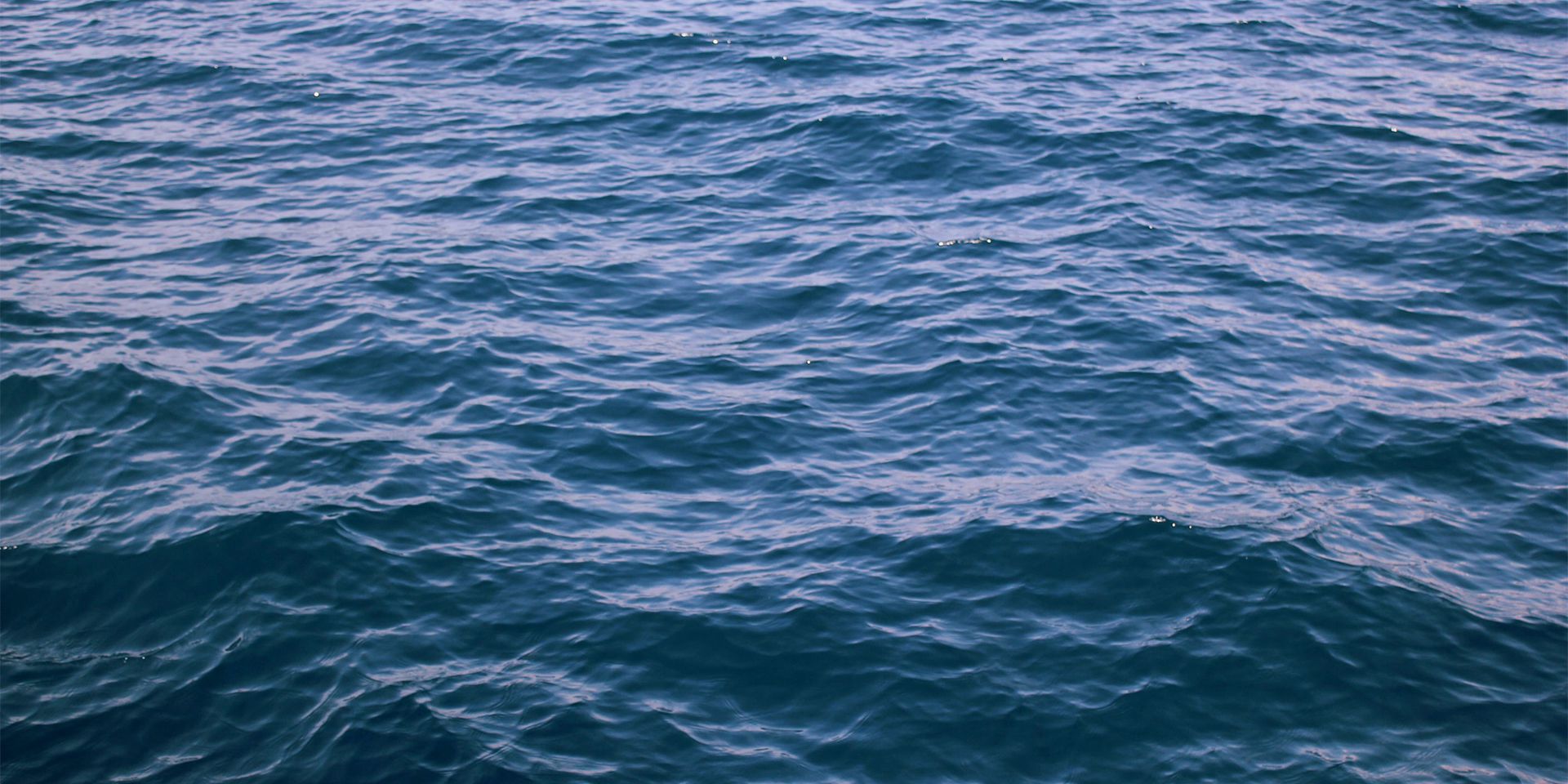Freshwater Dolphins and Porpoises
Freshwater cetaceans include some of the world’s most highly adapted (= specialized) and threatened mammals. One species, the Yangtze River dolphin or baiji, became extinct early in this century. Five of the seven currently recognized cetacean species that are either obligate inhabitants of fresh water, or have freshwater geographical populations, occur in Asia. The other two species (with several subspecies) are found in the Amazon, Araguaia/Tocantins, and Orinoco River basins of South America. All of the freshwater species, subspecies, and populations that have been assessed for the International Union for Conservation of Nature (IUCN) Red List are considered endangered or critically endangered.
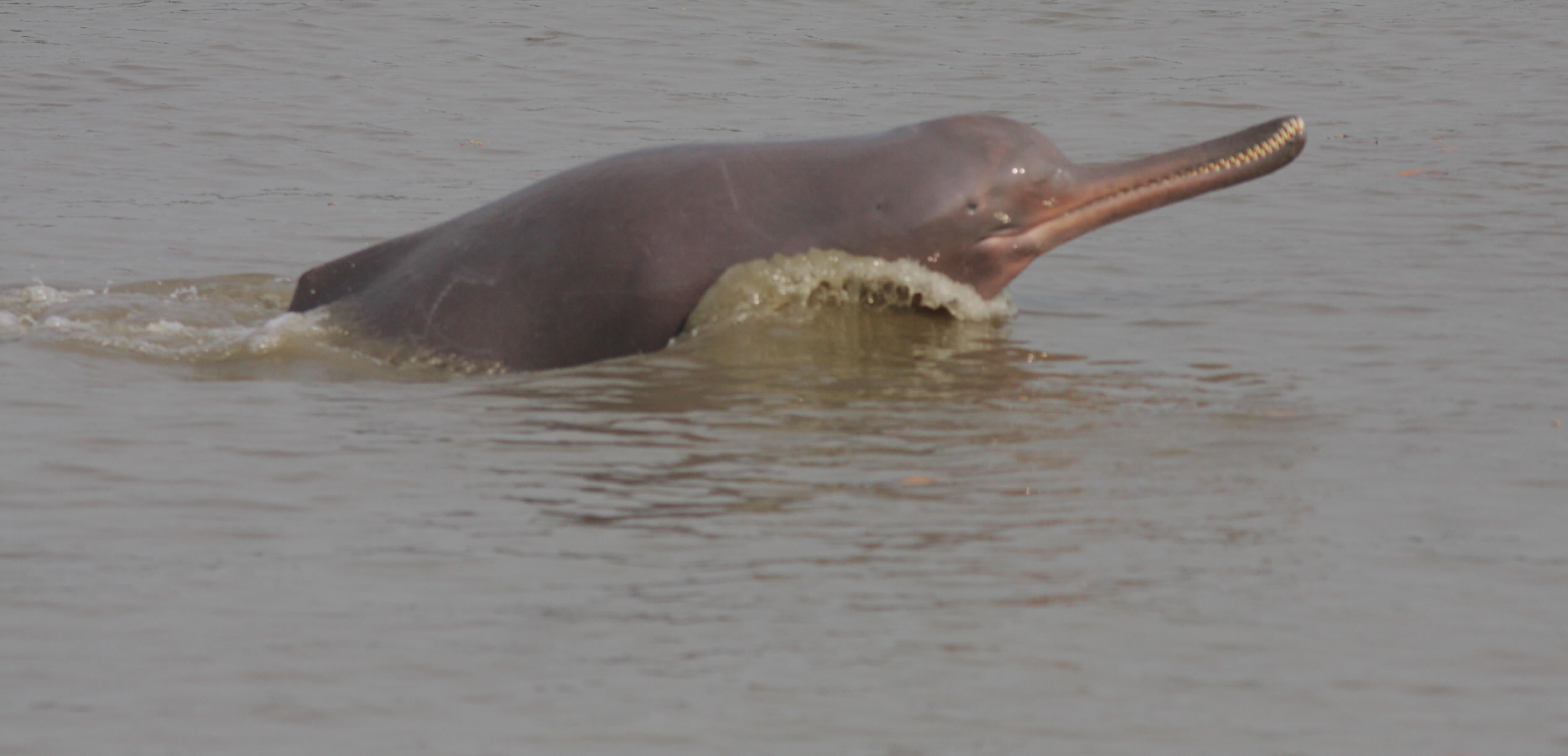
The South Asian river dolphin, Platanista gangetica, is found in India, Bangladesh, Nepal and Pakistan and includes two subspecies, the Ganges river dolphin and Indus river dolphin. (Zahangir Alom)
Species Status
Abundance
Freshwater cetaceans (including six dolphin species and a porpoise) have declined dramatically in numbers and range, especially in Asia. The baiji (Lipotes vexillifer), a freshwater dolphin endemic to the Yangtze River in China, was declared extinct in 2006. The last verified sighting of this species occurred in 2002. Unsustainable bycatch in local fisheries likely drove this species to extinction.
Freshwater cetacean abundance is difficult to assess because populations are often broken up into different subpopulations, sometimes spanning multiple countries. Most populations, however, are thought to be declining and all are listed as endangered or critically endangered by the International Union for Conservation of Nature’s (IUCN’s) Red List of Threatened Species. For example, the boto (Inia geoffrensis), an endangered Amazon river dolphin, can be found in two river basins across six countries, from the river delta upstream to where the waters become impassible. There is no range-wide estimate for abundance or trend in abundance for this species, although they are generally thought to be declining. Monthly surveys have occurred in one section of the Brazilian Amazon since 1994 and have revealed a 6.7% annual decline in boto sightings from 2000 to 2017. In this same area, another Amazon river dolphin, the tucuxi (Sotalia fluviatilis), also appears to have declined by 7.4% annually from 1994 to 2017.
Distribution
Freshwater cetaceans can be found in South America, in the Amazon and Orinoco river basins in Brazil, Bolivia, Colombia, Ecuador, Peru, and Venezuela, and in Asia, throughout several river systems in China, India, Bangladesh, Nepal, Pakistan, Indonesia, Cambodia, and Myanmar. Historically, many of these species ranged from tidal deltas into lakes and tributaries far upriver. Waterfalls, rapids, and shallow water, as well as man-made structures like dams, can act as barriers to dolphin distribution. This often results in completely or partially isolated subpopulations of cetaceans throughout the river basin. Many freshwater dolphins prefer shallow, murky water, and as a result have evolved to have poor eyesight, instead relying on echolocation to navigate and locate prey.
Mekong River Population of Irrawaddy Dolphins
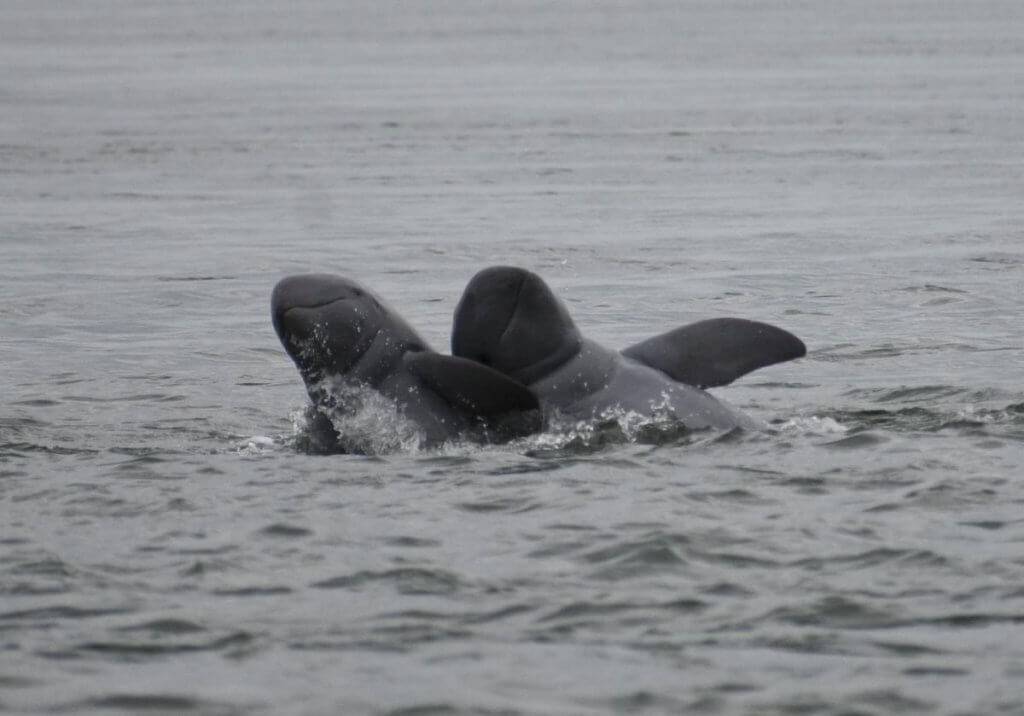
A pair of Irrawaddy dolphins in the Mekong River (Photo courtesy of Jason Allen, of the Sarasota Dolphin Research Project).
In January 2023, the Commission supported the travel of an expert group to Cambodia to work with WWF-Cambodia and the Fisheries Administration on their research and conservation efforts on Mekong River Irrawaddy dolphins, continuing an international collaboration underway for over a decade. The most recent population estimate in 2020 was 89 and there is concern over the number of animals lost from the population over the last few years, as 26 have been found dead since then. Commission Chair Gulland conducted necropsy training for the WWF staff and the river guards, focusing on the diagnosis of bycatch and specimen archiving. She has been involved with the local team since 2009, evaluating causes of death in the population. Jason Allen, from the Sarasota Dolphin Research Project of the Chicago Zoological Society, participated in a photo-identification survey of the current dolphin habitat and worked with the team on photo-id methodology and analysis, continuing training started during a Commission sponsored capacity building trip of the Cambodian team to Sarasota in 2018. Dr. Brian Smith of the Wildlife Conservation Society focused on the river guard and law enforcement situation and Ph.D. student Sarah Tubbs from Newcastle University engaged with the team on survey methods, exploring the use of acoustic detections in the river. The trip came at a time of intense focus on the dolphins in Cambodia, as three dolphins were found dead in fishing gear in late December, spurring the Prime Minister of Cambodia to call for increased protection from this primary threat to the existence of this population. Led by Executive Director Thomas, the visiting expert team met with the Cambodian Director General of Fisheries, the U.S. Ambassador to Cambodia, and the USAID mission team to draw attention to the need to take further action to protect this small population.
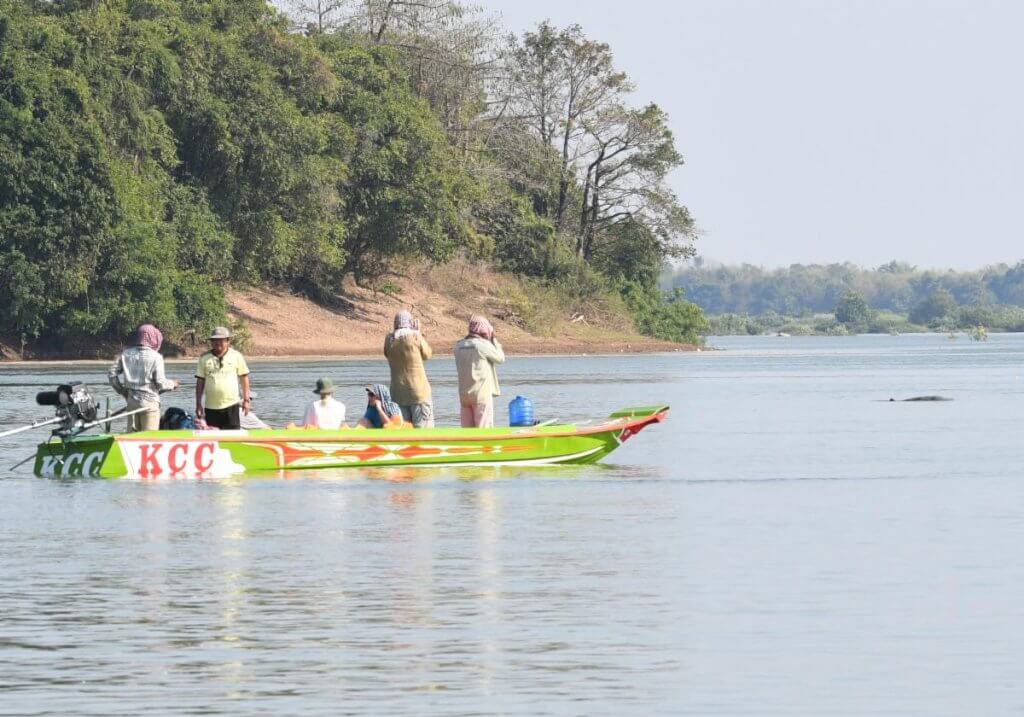
The photo-ID survey team for Irrawaddy dolphins in the Mekong River (Photo courtesy of Jason Allen, of the Sarasota Dolphin Research Project).
What the Commission Is Doing
The Marine Mammal Commission supports both targeted efforts to address the conservation of specific populations and regional efforts to strengthen freshwater cetacean conservation. Also, through its regular participation in the work of the International Whaling Commission Scientific Committee’s Sub-committee on Small Cetaceans, the Marine Mammal Commission seeks to make sure these “non-marine” marine mammals are given due consideration in accordance with their exceptional vulnerability.
Asia
In October 2009, the Commission co-sponsored a workshop in Samarinda, Indonesia, on Establishing Protected Areas for Asian Freshwater Cetaceans in Asia. Additionally, the Commission provided expertise to a meeting to draft an Indus River Dolphin (Platanista gangetica minor) Conservation Strategy and Action Plan, 2012 – 2022, held by WWF-Pakistan in Lahore, Pakistan, April 3-4, 2012. The Commission provided grant support to Gill Braulik for research on distribution, abundance, habitat use, and taxonomy crucial to understanding the conservation needs of the Indus River dolphin.
The Commission also participated in the Third Southeast Asian Marine Mammal Symposium (SEAMAM III) in Langkawi, Malaysia, from March 4-10, 2013. SEAMAM III considered issues related to the conservation and biology of coastal/inshore, estuarine and riverine marine mammals in Southeast Asia.
On December 9, 2014, an oil tanker collision spilled 350,000 liters of furnace oil into the waterways of the world’s largest mangrove forest in the Sundarbans, Bangladesh. This spill had the potential to impact the freshwater Ganges River dolphins (Platanista gangetica gangetica), as well Irrawaddy dolphins and finless porpoises (Neophocaena asiaeorientalis). In support of a joint United Nations/Government of Bangladesh Sundarbans oil spill response mission, the Commission funded Brian Smith and the Sundarbans biologists from the Wildlife Conservation Society to provide their expertise on the marine and freshwater cetacean species of the area and assist in the management of the spill and assessment of its impacts.
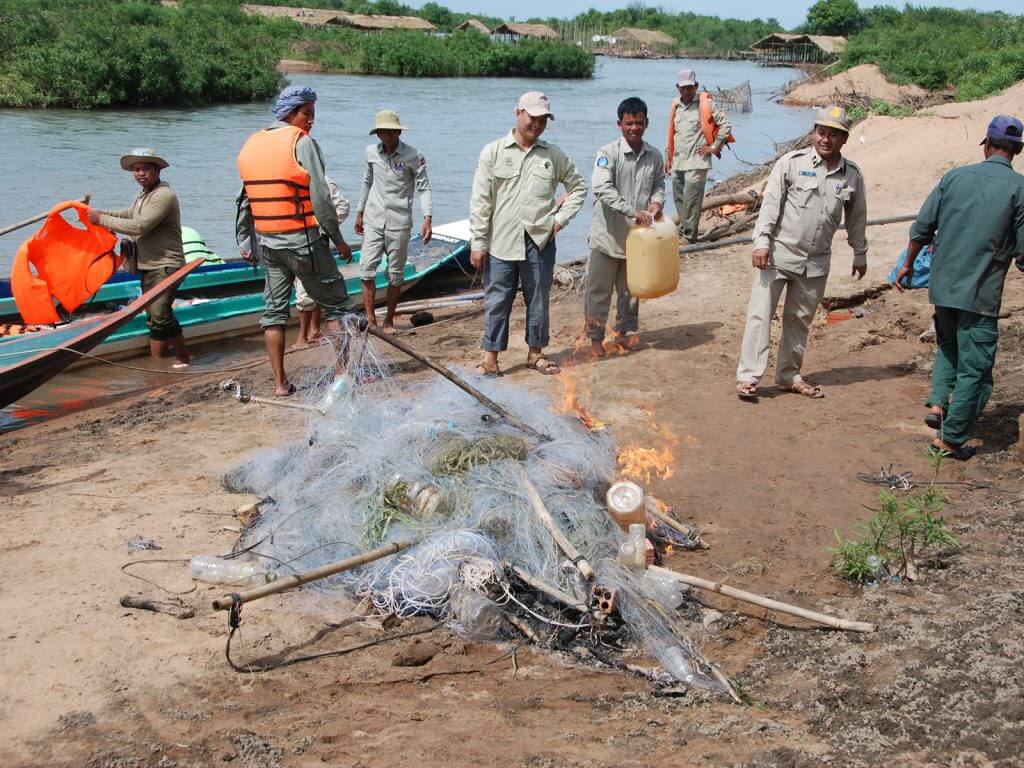
Mekong river guards burn confiscated gillnets removed from the core zone of Mekong river dolphin habitat. (Peter Thomas, Marine Mammal Commission)
The Irrawaddy dolphin (Orcaella brevirostris) population in the Mekong River has been reduced to fewer than 100 individuals, primarily due to entanglement in fishing nets. The Commission has supported WWF-Cambodia and the government of Cambodia in bringing experts on marine mammal health, demography, and behaviour to the country to assist them in assessing the threats to this population and developing conservation strategies and on-the-ground capability in the areas of science, law enforcement and health assessment. In January 2017, the Cambodian fisheries agency reported on progress in removing gillnets from the core zone of the Mekong River dolphins. Subsequent to this workshop the Commission partnered with the Chicago Zoological Society to bring a team of Mekong dolphin researchers to Sarasota Florida for two weeks of exchange and capacity building with the Sarasota Dolphin Research Program. This was overshadowed by news of the proposed construction of the Sambor and Stung Treng hydropower dams. If built, these dams will eliminate or transform most of the dolphins’ remaining riverine habitat. In March 2020 the Government of Cambodia announced the welcome news of a ten-year moratorium on dam construction on the Mekong River mainstem and a shift to a focus on other renewable energy resources. WWF convened a virtual Trinational Workshop in December 2020 to review conservation efforts for the three Irrawaddy dolphin populations in Cambodia, Indonesia, and Myanmar and to update recommendations for action on the Mekong, Mahakam, and Ayeyarwady Rivers.
South America
Commission representatives participating in the Scientific Committee of the International Whaling Commission have worked in the Sub-Committee on Small Cetaceans to draw attention to the impact of the use of meat from the two Amazonian freshwater cetacean species, the boto (Inia geoffrensis) and the tucuxi (Sotalia fluviatilis), for bait in the piracatinga catfish fishery. The government of Brazil responded to the recommendations of the Scientific Committee by placing a five-year ban on fishing for and marketing piracatinga in January 2015. Nevertheless there is strong evidence that the practice of using dolphins for bait continues and that much greater attention to this issue, and to other problems facing South American freshwater dolphins, is warranted.
Commission Reports and Publications
For more information on freshwater cetaceans, see Commission’s 2010–2011 annual report report and 2012 annual report.
Commission Letters
| Letter Date | Letter Description |
|---|---|
| August 21, 2017 | |
| April 26, 2016 | |
| March 31, 2014 |
See also: Ambassador’s_response_letter |
Learn More
Threats
The threats to freshwater cetaceans are diverse, longstanding, and difficult to assess and manage. Bycatch in fishing gear (entanglement or entrapment, usually leading to death) is the most serious and immediate problem for most populations, and gillnets are the greatest currently recognized cause of human-induced mortality. Freshwater cetaceans are also vulnerable to habitat modification and degradation (e.g., noise, chemical pollution, dams, lack of stream volume), and they compete with humans for prey. Vessel strikes, under-water explosions, the shock from electro-fishing, and entrapment in water management structures, notably irrigation canals, can cause injury or death. Some of these factors kill animals outright, and others impair their health or undermine their reproductive capabilities and social behavior. Unlike marine cetaceans, many freshwater animals live in environments where the very availability of water can be in doubt.
In freshwater (and estuarine) ecosystems, more so than in coastal or oceanic systems, such basic elements are finite and may be completely regulated, modified, or destroyed by human activities. The constricted nature of riverine habitat, and the inescapable need to share that habitat with humans, increases the vulnerability of these animals to bycatch in fisheries, overfishing of their prey, disturbance by noise, and being struck or displaced by vessels. In Brazil, Amazon River dolphins, or botos, and tucuxis are killed and used for bait in a fishery for a catfish, the piracatinga. Although most of the identified threats to freshwater cetaceans are widespread, and most freshwater cetacean populations face multiple threats, the types and intensity of human activities differ between different rivers. Nonetheless, in all cases, the human impact on river systems and on freshwater cetaceans is significant.
Current Conservation Efforts
The Commission continues its engagement on freshwater cetaceans both within the IWC’s Scientific Committee and through interactions with field researchers and conservationists in Asia and South America. The threats to freshwater cetaceans are ongoing and the impacts of human development need to be managed.
In 2017, the IWC formed the South Asian River Dolphin Task Team to assess the threats of habitat loss and bycatch to Ganges and Indus river dolphins. Scientists in India, Pakistan, and Nepal are working to coordinate efforts and develop a transnational plan to help conserve these species. The team is also working with the IWC’s Bycatch Mitigation Initiative to determine how future monitoring plans and alternative fishing gear technologies could reduce injury and death.
In 2021, the IWC adopted its first freshwater cetacean conservation management plan (CMP). The Amazon River Dolphin CMP was developed by the governments of Brazil, Colombia, Ecuador, and Peru. The plan outlines actions needed to assess dolphins range-wide and to identify and mitigate threats in the short and long term. The plan focuses on threats including deforestation, habitat fragmentation due to dams, mercury contamination, overfishing, bycatch, and climate change. It also focuses on using research to influence management and policy decisions. So far, over 45 botos have been tagged, mercury exposure and bycatch deterrent studies have been conducted, and a 2022-2023 workplan has been developed. Ongoing work includes determining how many species, subspecies, or subpopulations exist, identifying regional and national policies, and linking CMP goals with deforestation control.
Also in 2021, China passed a law to improve the protection and restoration of the Yangtze River basin. Many of the new measures will also promote the recovery of the Yangtze finless porpoise, including a ban on fishing in the Yangtze River and its tributaries for 10 years and a ban on the construction of chemical plants within 1km of the river. The IWC Scientific Committee recently highlighted the dire situation of the Yangtze finless porpoise which, without additional conservation efforts by the Chinese government, may follow the baiji to extinction in this heavily industrialized, densely populated river system.
In 2023, Cambodia’s prime minister ordered the creation of dolphin protection zones that prohibit fishing on the Mekong River. The Commission is encouraging further work on Irrawaddy dolphin conservation and behavior in the Mekong as enforcement efforts are strengthened there and is working to build support for efforts to understand and address threats to Irrawaddy dolphins in Myanmar and Indonesia.
